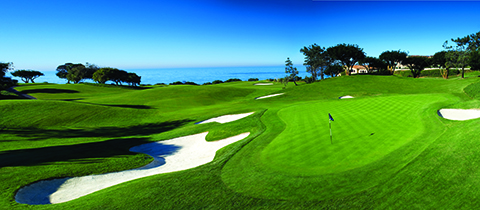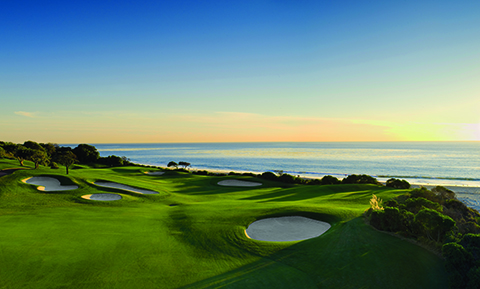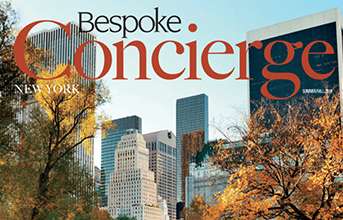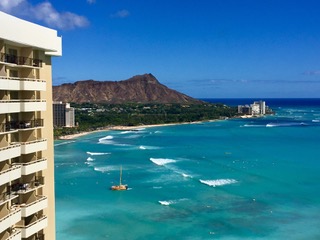The Monarch Beach Golf Links’ classic layout by Robert Trent Jones Jr. is an oceanfront beauty that packs a strategic challenge unfazed by the passage of time.
By Dale Leatherman
Along California’s more than 1,000 miles of stunning coastline, there are only a handful of courses with holes overlooking the Pacific Ocean. Additionally, it is a rare amenity to boast views of the sea from all 18 holes, as does the award-winning Monarch Beach Golf Links at The St. Regis Monarch Beach.
“Golf course designers will do almost anything for a site on the ocean because it creates great drama and, obviously, beauty for golfers and nongolfers alike,” says golf architect Robert Trent Jones Jr., whose creativity and environmental savvy have earned him commissions on many enviable sites across the globe including the Monarch Beach course, which opened in 1983.
The decade before the course opened was a turbulent time because the newly formed California Coastal Commission was deciding how best to regulate development next to the sea, Jones says. At first, the commission deemed golf courses an inappropriate use of precious coastal land because they weren’t free to the public, like beaches. However, testimony by Jones and others would change that opinion.
“Eventually, golf courses were not only permitted by the commission, but also became a priority use within the coastal zone of the entire state,” Jones says. “So we were able to build this wonderful course with the support of the commission, the community and other agencies.”
A Course With Character
Monarch Beach Golf Links was designed to be a community and resort course, not a competition layout like Torrey Pines Golf Course, Jones notes. “It’s intriguing and challenging, but it’s also a fun course; not so difficult that you don’t want to play it again,” he says.
In an era when golf courses are becoming progressively longer, Monarch Beach Golf Links’ 6,600-yard, par 70 layout may seem tame. However, at sea level the air is heavier, so the course plays like a 7,000-yard layout in Scottsdale, Ariz., or a 7,200-yard track at elevation, according to general manager Eric Lohman. More than 98 strategically placed bunkers and 11 water hazards contribute to the difficulty.
“Length is only one of the elements in a course design—something the young ‘limberbacks’ pay attention to,” Jones says. “Width, contour, bunkers and other hazards—and chipping and putting challenges—also test the golfer.
“There’s a lot of water on the course, including the big ‘pond’ of the Pacific,” he adds. “Conserving water and making the best use of it is one of the most important tenets of all of our designs, and this is extremely important in California, considering the drought. An acre of water uses less water than an acre of grass—and water is part of the drama. It’s a beautiful hazard.”
In forming the course with all those water hazards, Jones moved a lot of earth from the residential construction area to the golf course in order to create elevation changes and spectacular views of the sea.
“Even though I grew up on the East Coast in New Jersey and played golf at Yale, I’m a three-dimensional architect,” he explains. “In my youth, I moved to the West and worked in Colorado and California, so I’m very much aware of elevation changes and how they affect shot-making.
“All in all, Monarch Beach has withstood the test of time,” Jones says. “Any well-maintained course can be beautiful, but this one also has character.”
Devilish Details
Though many golfers get carried away by the presence of the ocean and describe the layout as Scottish links style, it’s actually a beautifully groomed parkland course with rolling, sometimes narrow fairways; deep bunker complexes with dazzling white sand; and severely undulating greens.
“The ocean setting definitely makes the course special,” says course superintendent Mat Dunmyer, who grew up in Buffalo, N.Y., and never tires of Southern California’s temperate clime and Monarch Beach’s proximity to the ocean. “I love the property and the location. Hitting a tee shot on hole 3 and watching it soar against the backdrop of the Pacific is a wonderful experience.
“But, it’s the green complexes that give the course its strategic impact,” he adds. “More than half the greens are tiered, so you need to be on the correct level—and hopefully not chipping out of a greenside bunker. They’re deep—especially on the front nine—and well placed around the greens. You’ll find open approaches where you can run the ball up, but we’ve shaved down the grass around some bunkers so your ball may feed into them. Most of the greens are elevated, so club selection is critical. The uphill approach shots mean you’ll need a half- to a full-club more, and you’ll have to adjust for the wind.”
There is no official signature hole, but hole 3 is a likely candidate. It’s a downhill, 315-yard, par 4 with a left dogleg to a green near the beach. The eye is drawn to Catalina Island and the parade of boats going by, but it’s not a good place to be distracted. Ocean gusts can play havoc with approach shots, and the putting surface is heavily sculpted. Hole 3 is followed by back-to-back par 3s, the first of which is 185 yards long and subject to wind off the sea. Hole 5 is even longer—217 yards over a ravine choked with foliage.
“Fortunately, the wind is behind you on this hole, and there’s a generous run-up area,” Dunmyer says. “As long as you’re headed in the right direction, you have a chance at par. There are bunkers on the left and water on the right.
“We have five par 3s on the course and all are unique,” he continues. “You’re hitting a different club to a different situation on each one.”
Staying Power
Jones and Dunmyer believe the course still provides a challenge for today’s golfer. During the 2013 Oakley Southern California Open last fall, Dunmyer watched a caddy look at the 6,600 yards on the score card and remark that someone would “tear the course up” and shoot a 60. It didn’t happen. PGA Tour pro Jason Gore won the tournament with a two-under-par 68 in the final round.
That said, recreational golfers who forego the championship tees and choose the tees appropriate to their handicaps are in for a fun round—and should not have many wounds to lick afterward. But if succor is needed, they’re in the right place: The St. Regis’ spacious ocean view suites come with complimentary butler service. Six restaurants, also overlooking the Pacific, offer a variety of fine dining choices. The resort’s private beach and three large swimming pools are just steps away from every suite. And the award-winning Spa Gaucin promises to restore body and soul.
On the theory that one can never have too much of a good thing, The St. Regis Monarch Beach offers a stay-and-play package with a day of unlimited golf for two. Or, one partner can opt for a 60-minute spa treatment while the other indulges in unlimited golf with those unparalleled views of the Pacific.
Lining up the Shot

From swirling sea breezes to deep bunkers, the Monarch Beach Golf Links comes with its own set of challenges despite the beauty of the ocean panorama. Eric Lohman, the course’s PGA general manager, offers his expert advice
for dealing with these obstacles and enjoying the resort’s amenities after a game.
Bespoke Magazine: When and why did you start playing golf?
Eric Lohman: I grew up on a golf course—the 16th hole of Spring Valley Lake Country Club in [the] High Desert, Calif. When I was 8, my brother and I participated in a summer camp featuring country club-type activities. It turned out that I hit the golf ball better than I swam or played tennis.
BM: What was your first job in golf?
EL: I was a range attendant at Mission Hills Country Club while I was attending Palm Springs High School. My second job was in college, working for Jim Flick and the Nicklaus/Flick Golf Schools in Pebble Beach, Calif.
BM: You’ve been at Monarch Beach for almost two years now. Is it a dream job?
EL: It’s a great job. I work next to the Pacific Ocean and the magnificent St. Regis Monarch Beach, with a wonderful team of hospitality-driven professionals. I have great owners, a supportive management team, and I host wonderful guests and members from all over the world. However, my dream job is to be a PGA Tour pro and drive my NASCAR stock car to Augusta each April to play in the Masters.
BM: What makes the Monarch Beach Golf Links unique?
EL: You can see the Pacific Ocean from all 18 holes [and] it has two holes beside the beach. It has three distinct sections—the five-hole ocean loop, the four Salt Creek Canyon holes and the upper back nine—all of which add great variety to the golfing experience. It has one of the best golf staffs in the country: Each one believes in personable customer service and making the guest’s golfing experience relaxed and unpressured. This Robert Trent Jones [Jr.] layout has elements similar to Augusta National [bunkering], some strategic risk-reward holes—and our greens can be quite devilish. I think our green surrounds are some of the best anywhere, providing a unique experience on each hole.
BM: What is the most difficult hole on the front nine, and how should it be played?
EL: At 612 yards from the back tees, hole 7 is a challenging par 5. To reach the green in two, you must hit a long, straight, aggressive drive over Salt Creek and avoid the plethora of fairway bunkers on the right. Then, the advanced … golfer would have to hit a longish approach shot—most likely with a low-lofted fairway wood—to a narrow, well-bunkered green adjacent to Salt Creek. On this hole, you’re always dealing with a swirling ocean breeze. If you’re not going for it in two, then you lay up on one of two fairways. The left fairway is tighter, but gives you a shorter shot and better angle to the pin. The right fairway is a safer layup, but results in a longer approach shot across Salt Creek.
BM: What’s the most difficult hole on the back nine, and how do you recommend it be played?
EL: Hole 11 is a straightaway par 4 that is uphill all the way. It’s only 415 yards, but plays more like 450-plus. The fairway and green are both well bunkered, and the putting surface pitches dramatically from back to front. To have a birdie putt—or even a two-putt for par—you must hit your approach shot on the correct level and below the hole. If you hit over the green and have to chip back on, be prepared to chip again from the front of the green or out of one of those dreadful, deep-faced bunkers guarding the green.
BM: Last year, the Golf Channel chose Monarch Beach as the nation’s No. 1 Ladies’ Golf Destination. How did it earn this accolade?
EL: Several factors went into the final decision: Our course isn’t overly long, it’s fair and it has ocean views on every hole. Our award-winning golf retail store showcases several women’s fashion groups, and we have personal shoppers for the ladies. Our golf staff is kind and supportive—and we make darn good bloody marys and margaritas. The St. Regis is a five-star, five diamond hotel, and the Spa Gaucin is in Travel + Leisure’s “Top 25 Hotel Spas in the World.”
BM: What other amenities does the course offer?
EL: In addition to the Golf & Resort Lifestyle Retail Store, the clubhouse contains men and women’s locker rooms and the Club 19 restaurant, which has panoramic views of the Pacific Ocean and Catalina Island. On the course, the Monarch Cafe is adjacent to the sixth and 10th tees, so a lot of our guests find themselves stopping in for a deli sandwich and beverages.










